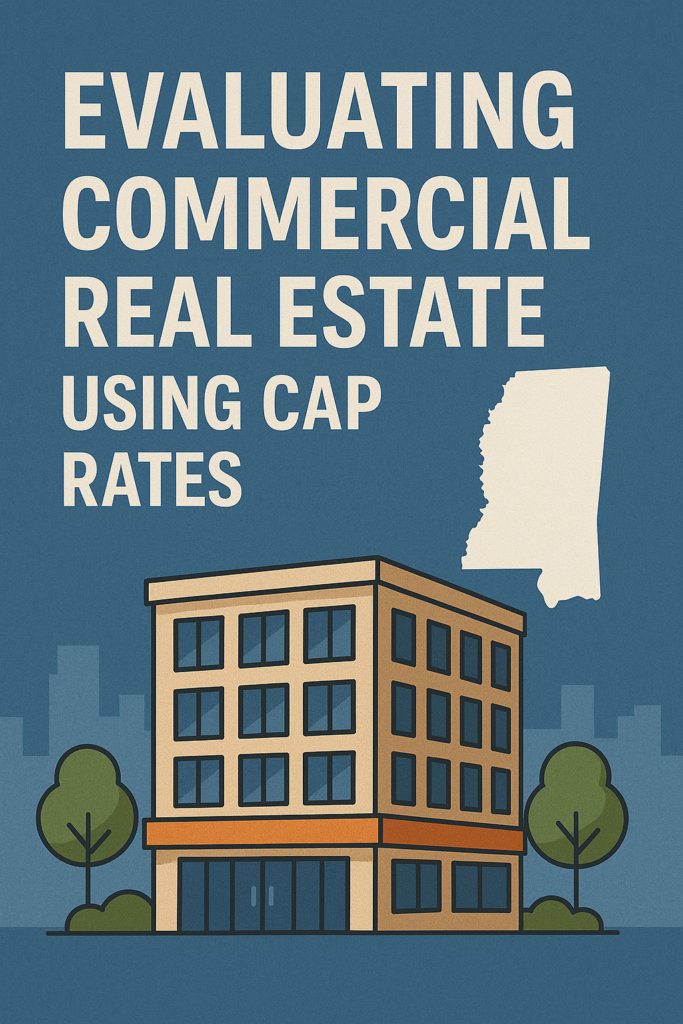
In Mississippi, evaluating commercial real estate starts with understanding what you’re really buying: a stream of income. Whether it’s a neighborhood retail center in Gulfport or an industrial site in Tupelo, the cap rate—short for capitalization rate—is one of the few universal metrics that cuts through the noise. It doesn’t guarantee performance, but it gives you a critical snapshot of a property’s yield based on current income and value. If you know how to use cap rates effectively, you can benchmark opportunities across different property types and market cycles with speed and confidence.
The cap rate is calculated by dividing a property’s net operating income (NOI) by its market value. If a warehouse earns $70,000 in NOI and is priced at $1,000,000, the cap rate is 7%. That’s your unleveraged return, assuming a cash purchase. Simple math—but what matters is how you interpret it.
In Mississippi, cap rates vary widely. A stabilized grocery-anchored center in Ocean Springs may trade at a 6.25% cap because of predictable tenant performance and limited risk. Meanwhile, an older mixed-use asset in downtown Laurel might show an 11% cap due to vacancy, deferred maintenance, or market softness. The number by itself doesn’t tell you if the deal is good. It tells you where to look deeper.
Start with the income. NOI should be current, stable, and reflective of real operations. In this market, buyers are seeing more scrubbed financials than ever—be skeptical of pro forma numbers that assume full occupancy or unrealistic rent bumps. Gulfport and Hattiesburg are seeing increased leasing activity, but don’t price that in unless it’s signed. Look for trailing 12-month figures and confirm expenses: taxes, insurance, repairs, management, and reserves. If the property is underperforming or newly renovated, determine what realistic income should look like based on comps.
Once you have an accurate NOI, you can reverse-engineer value using market cap rates. This is where local knowledge matters. Investors buying medical office in Jackson might accept a 6.5% cap because of tenant credit and demand. But self-storage in rural counties could trade at 8.5–9% due to volatility and lack of buyer depth. Use broker opinion of value (BOV) data, assessor records, or recent trades to find the right rate. Don’t rely on national averages—they’re irrelevant in local negotiations.
Cap rates also help frame the risk-reward tradeoff. High cap rates generally reflect high risk: declining population, poor asset condition, weak tenants. Low cap rates typically point to income stability or asset scarcity. That doesn’t make one better than the other—it depends on your objective. If you want a yield play, you might pursue an older multifamily in Meridian at a 10% cap with upside via renovations and rent increases. If you want low-touch cash flow, you’ll probably stick with single-tenant net lease deals in places like Madison or Flowood, even if they trade at a compressed 5.75%. The cap rate also shifts over time. What looked like a 7% yield at purchase might compress to 5.75% five years later because rents increased, the market improved, or inflation boosted replacement costs. The reverse happens too—tenants leave, expenses rise, and the effective cap rate deteriorates. This is why cap rate alone is never enough. It’s a snapshot, not a trend line.
To make the metric work for you, layer in time-based analysis. Ask yourself: Is this a value hold or a value-add? Can I increase NOI through lease-up, mark-to-market, or expense controls? If so, what will the cap rate be in 12–24 months? A property in Biloxi might be trading at an 8.5% cap today due to vacancy, but if lease-up is achievable within a year, the effective stabilized cap could drop to 6.75%, representing an attractive gain.
You should also track whether the current cap rate aligns with broader market movement. Mississippi doesn’t behave like Miami or Dallas, but local catalysts still matter. The I-10 corridor is growing. New employers are pushing activity in Tupelo and the Golden Triangle. Gulfport’s port expansion is a long-term tailwind for industrial users. These shifts can compress cap rates quickly. If you’re seeing deals that look “too rich,” it might be a sign the market is already moving.
One mistake we see is failing to pair cap rate analysis with capital stack reality. Financing terms can swing deal returns. A retail center at an 8% cap might generate a sub-6% cash-on-cash return once you account for mortgage costs. On the flip side, if you lock in favorable terms—say 65% LTV at 5.25%—your leveraged return might outperform. Always reconcile cap rate with internal rate of return (IRR), equity multiple, and CoC return. The cap rate is where you start, not where you stop.
Also factor in exit. Cap rate compression is one of the best drivers of upside—but only if it’s likely. If you buy at a 9% cap in Pascagoula and five years from now it’s still a 9% market, your value creation will rely solely on income growth. Conversely, if you acquire a 6.75% deal in Oxford and the market tightens to 5.75% by the time you sell, you’ll see a meaningful lift in resale price even without major NOI growth.
In short, cap rates in Mississippi are neither formulaic nor static. They are driven by local economics, tenant credit, asset type, and future upside. Whether you’re chasing appreciation or income, the cap rate offers a lens to understand pricing and compare deals on a risk-adjusted basis.
But it’s not the endgame.
Once you’ve found a deal that checks the boxes on paper, pressure test it. Stress the income. Sensitize the vacancy. Confirm the comps. Cap rate tells a story—but make sure you write the ending yourself.